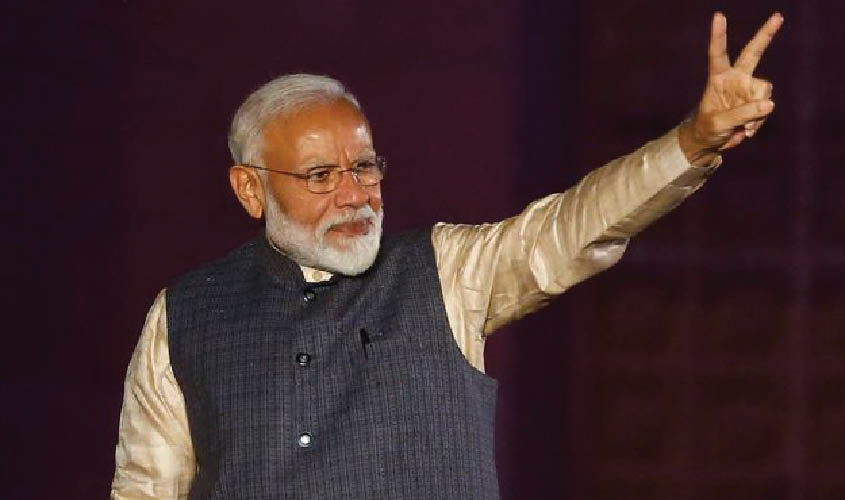A day after winning a landslide victory in the Lok Sabha elections, when Prime Minister Narendra Modi, accompanied by Bharatiya Janata Party president Amit Shah, called on Lal Krishna Advani and Murli Manohar Joshi to seek their blessings, it reminded me of events dating back to 1990. Advani, the first Hindutva icon, was the chief of the saffron outfit, which at that time, was, along with the Left parties, supporting the Vishwanath Pratap Singh government at the Centre. V.P. Singh, in a bid to thwart a challenge to his authority from his Deputy Prime Minister, Devi Lal, notified the implementation of the Mandal Commission report, which was met with widespread protests and frenzied outcry. It was at this juncture when in order to end the caste conflicts, Advani announced his Somnath to Ayodhya Rath Yatra.
The sole objective of the Yatra was to unite Hindu society, which was being fragmented by the caste-card played out by V.P. Singh. It has been an old RSS practice that whenever caste factor becomes dominant, the only effective way of countering it is to bring in religion. However, the Rath Yatra was organised without the approval of the RSS and the late Pramod Mahajan was chosen by Advani to be his escort.
The journey, aimed at awakening Hindu sentiments, ended when the then Bihar Chief Minister, Lalu Prasad Yadav, brought the Rath to a halt. As a result of which the BJP withdrew support to the V.P. Singh government, ensuring that it collapsed, facing no-confidence motion in Parliament.
During the present elections, the caste Mahagathbandhan in Uttar Pradesh and a similar arrangement in Bihar and some other states sought to halt the Modi juggernaut. The arithmetic favoured the Opposition, yet the BJP managed to trounce its opponents with decisive mastery; the reason being that Modi, who has done his political apprenticeship under Advani and Joshi, used the tried and trusted formula of Hindu assertion to combat the formidable caste combinations and permutations. In order to reinforce the strategy, he used robust nationalism as a strong ingredient by his frequent outbursts against Pakistan, which has been covertly and overtly supporting Islamic militancy in India. The aggressive campaign of the PM played on the emotions of the large Hindu population, which in the end lent its wholehearted support to Modi so as to propel the BJP to a spectacularly unprecedented victory in the elections.
A contest, which at one stage was billed between Modi of 2014 and Modi of 2019, turned out to be a confrontation which pitted Modi against the rest. At one level, the outcome was heavily tilted towards the PM, and on the other hand, it established beyond any doubt that Hindu Rashtravad had triumphed in India. Modi vanquished his rivals with ease and in the process spelt out in no uncertain words that Hindu pride would no longer take a back seat. The talk of secularism was all posturing and inconsistent with the overall mood prevalent in the country.
Although the 2019 victory has been solely scripted by the Prime Minister with proactive collaboration from Amit Shah, there were strands of Advani’s political legacy that were clearly visible in the blueprint. The RSS has always desired India to be a Hindu Rashtra, a thesis which was in conflict with the secular dimension of our Constitution. Modi’s five-year tenure and his campaign have touched a palpable chord in the hearts of the majority of Hindus. The arguments of the campaign, and the eye-catching symbolism and perceptible images deployed extensively during the electioneering, convinced a sizeable section of the Hindu population that they had been marginalised during the terms of earlier dispensations, which had a tendency of favouring minorities.
Modi too, like Advani, is convinced that India is a secular country primarily because it is predominantly Hindu; had it been dominated by some other religion, its secular credentials would have been in serious doubt. In the early 1990s, while responding to a query from a British journalist on whether he wanted to convert India into a Hindu Rashtra, Advani had given a very apt reply. He informed the interviewer that India was largely a Hindu majority country just as Britain was a Christian dominated nation. He elaborated that like in UK, where people of every faith lived and thrived, they could do so in India as well.
Modi’s articulation of the same doctrine is not as subtle, and in the past five years he has, without naming communities, been declaring that he was a firm believer in “Sab ka Saath, Sab ka Vikas”. On Thursday evening, he again reiterated that there were two kinds of Indians: those who were below the poverty line and others who were waging a war against poverty. His comment bore similarities with the way Indira Gandhi would also put across her point of view. She would never use the word minorities but emphasised on emancipating the “pichde varg”. Her political idiom, however, was not adopted by the current leaders of the Congress.
Modi’s statement was meant to send a secure signal to the Muslims in particular that he was concerned about their welfare, while simultaneously, with a master-stroke, assuring the Hindus that he was not leaning towards any one section. In 2014, the Congress was badly affected due to the perception that it was pro-minorities. Needless to say, Modi would never make such a mistake. Between us.

